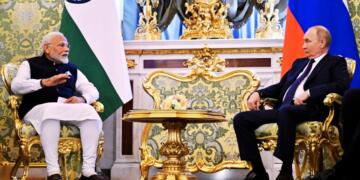The Aftermath of Operation Sindoor India has effectively been able to fulfil its objectives by Operation Sindoor in more than one ways. First of all, India has clearly communicated that any forthcoming sub-conventional attacks (that involves non state actors & terror groups) will be met with a conventional response (militarily). It emphasizes that now Pakistan has a duty to avert any sub-conventional assaults if it seeks to avoid conventional retaliation from India.
In effect, India has blurred the line between the non-state actors and the Pakistani establishment by holding the latter responsible for the acts of formal and even being complicit. Also, while Pakistan has consistently tried to internationalise the Kashmir issue, India has maintained that Kashmir is a bilateral dispute. American mediation and President Trump mentioning the K word (Kashmir) in his social media posts suggests that Pakistan has been successful in weaving the narrative, but one must remember that the ceasefire agreement between the two countries does not address India’s choice to suspend the IWT.
Pakistan used to get a lion’s share of water from the IWT (more than 80%), it needs water for its agriculture and other purposes. India on the other hand, targets Pakistan sponsored terrorism. As a result, the new framework for bilateral discussions will require India to demand that Pakistan halt its terrorist activities as a condition for the reinstatement of the IWT, rather than India agreeing to engage in discussions about Kashmir in exchange for Pakistan’s promise to combat terrorism.
So the stakes for Pakistan have been remarkably raised. Earlier, Indian attempts to thwart terrorist attacks sponsored by Pakistan have not yielded the desired results. India tried to create strong defences to prevent the success of terror operations backed by Pakistan, but defence alone can’t guarantee complete security. It’s like expecting to win a football match with strong defenders & not formidable strikers – the ones who score the goal. Effective deterrence requires scoring goals, which involves retaliating against Pakistan in response to terrorist acts.
Also, solely depending on military responses is insufficient to significantly change Pakistan’s behaviour. India is aiming to create a framework of disincentives that makes Pakistan recognize that the advantages it derives from sub-conventional actions are greatly outweighed by the increased costs it incurs as a result of these actions. IWT would act as an effective tool for India to establish deterrence. Operation Sindoor has further amplified India’s unwavering dedication to decisively combat terrorism, without caring about the consequences. Although Modi Government has expressed this determination for some time but through Operation Sindoor it has now established a new normal and changed the rules for engagement that any act of terror would be retaliated militarily & publically.
This is in contrast to the covert operations of 2016 & the airstrikes of 2019 that were acknowledged after the operations. Now India has established a well-publicized deterrent framework that increases the stakes for Pakistan from breaching the boundaries. The visual order of this newly established framework would continue to haunt Pakistan for years to come. India’s objective is not only to carry out punitive actions but also to be seen as doing so.
The message from India to Pakistan is loud & clear – just giving space to terror outfits is enough of a provocation for India to retaliate. Another ramification of Operation Sindoor would be seen on India’s ties with one of its strategic partners – the USA. The relationship between Trump administration & Modi administration have been very good but American attempts to end the Indo-Pak confrontation and his post on social media which mention ‘increasing trade with both these great nations’ has a patronising undertone. For years, global leaders have exercised caution against planning their visits to India at the same time as those to Pakistan.
The United States has now tried to establish a misleading equivalence between the victim and the offender & while doing so it also re-hyphenates India and Pakistan in the global discourse. Trump indicated that he threatened to suspend trade in order to impose a ‘ceasefire’ between India and Pakistan.
Well, it’s a fact that the possibility of rolling back the tariffs does give US leverage over its allies and adversaries alike. Leading scholar of IR, Prof. John Mearsheimer didn’t rule out that Trump might have promised a ‘sweetheart deal to India’ if it ends the confrontation. But playing hard ball with India could backfire, particularly in defence procurement and the level of support India might provide to the US in a possible conflict with China. PM Modi is known to have a long memory! President Trump is opting to exacerbate India-US relations with inept diplomatic efforts, it is crucial for the White House to adopt a realistic approach.
US needs India in Indo-Pacific to check a belligerent China but it seems that US also needs Pakistan to ensure that India doesn’t become a second China. India-US ties could be best described as ‘friends with benefits. Overall, the most significant message Operation Sindoor coveys is that India would respond disproportionately in case of any terror attack & not only it would respond but respond in a way that hits the heart of the well-oiled terror machinery nurtured by Pakistan as their State policy. In his address to the nation on may 12th, PM Modi clearly enunciated a new Indian doctrine related to the link between terrorism and nuclear option. No Indian PM has talked in such unmitigated & uncompromising way.
India has institutionalised a new template, never before in history a nuclear power State has been hit at twelve of its military bases with such impunity. The nuclear blackmail is no longer feasible for Pakistan which it has often tried to use as a leverage against India. India’s response to the terror attack in Pahalgam would remain a profound moment of Indian security and strategic doctrine.





























